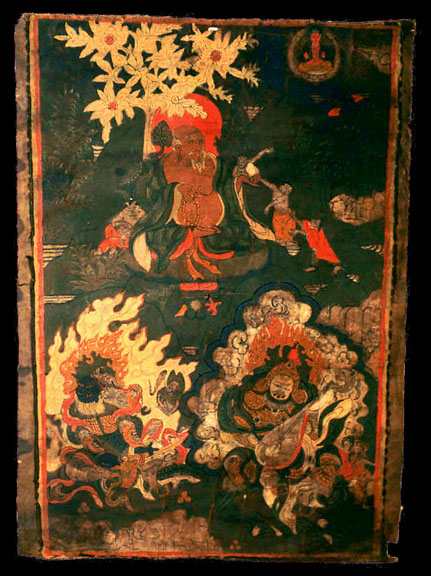寫經 (pinyin: xiě-jīng) literally means “copy sutra”. Koreans pronounce it as sagyeong (사경). In Japanese Buddhism it is pronounced shakyo. And to keep us on our toes, the Japanese use two different Chinese characters: 写経 (don’t ask me why – but the first character, 写, is the cursive form of 寫, and the second character, 経, is just the Japanese variant of 經).
Since I have been “brought up” in the Korean tradition, I’ll use 寫經, but I won’t (for the most part) use either sagyeong or shakyo, but rather just refer to “sutra copying”.
Personally, I think if one is going to take up the practice of sutra copying, the best place to start is with the relatively short Heart Sutra. And even that is quite an undertaking, especially for someone who is starting from scratch.
So let’s just look at the first line of the Heart Sutra, with 10 characters:
摩 訶 般 若 波 羅 蜜 多 心 經
ma
ha
ban
ya
ba
ra
mil
ta
shim
gyong
I am going to take a leisurely approach to all this, so for now I just want to look at the first two characters: 摩訶, which is the Chinese transliteration of the Sanskrit महा (mahā́), which means “great”. Of course there is a perfectly good Chinese word for “great”, which is 大 (dà), and even a word for “really great”, which is 太 (tài).
I like tangents, and I feel one coming on now. Later on in the Heart Sutra (remember, we’re just supposed to be looking at the title for now), we encounter the lines: “Therefore know that Prajna Paramita is the great transcendent mantra, is the great bright mantra….” But in these cases, the Chinese version just uses 大. I only point this out, because when I first started trying to figure out how to write the Heart Sutra in Chinese I was very perplexed to not find 大 at the very beginning – especially since this was one of the very few Chinese characters that I was already somewhat familiar with.
But now lets return to the first two characters of the first line/title of the Heart Sutra: 摩訶.
摩, the first character in the Heart Sutra, is one of my favorites. The pinyin for it is mó, so it’s not a particularly obvious candidate for transliterating the first syllable of the Sanskrit महा (mahā́). Something that I have observed over time is that the Chinese apparently didn’t really care for the prevalence of “ah” in Sanskrit, and the concomitant dearth of other vowels. And so when “transliterating” Sanskrit they (or so it seems to me) had a tendency to jazz things up by turning “ah” into “oh” a lot. Just an observation.
The actual meaning of 摩 is kind of interesting in its own right. It means “to scrub, scour, or grind” – but it also means, less literally, to “investigate, study, research”. This character is made up of three simple characters: 广 + 林 + 手 (“vast” + “forest” + “hand”). So my personal mnemonic for 摩 is “vast forest of hands” – which I think sounds cool and is also reminiscent of Avalokitesvara’s “thousand hands”.
Another interesting thing about 摩 is that it is very similar to 魔 (also pronounced mó), which is the character for “magic”, “sorcery”, and “the occult”. It is formed by replacing the 手 in 摩 with 鬼 (guǐ), which is the character for “ghost” or “spirit” or even “demon”.
Now on to the second character, which is 訶 (pinyin: hē). This character means “scold loudly, curse, abuse”. 訶 is formed by combining 訁(yán), which means “to say, to speak, to talk”, with 可 (kě), which means “can, may, be able to”, which is a lot less interesting than “vast forest of hands”, sadly.
But now lets deviate a little from the Heart Sutra. Since we now have the characters for “maha” we are halfway to having the Chinese transliteration for “Mahayana”, which is 摩訶衍那. Now, sometimes Chinese Buddhists translate महायान (mahāyāna) as 大乘 (dà-chéng), which just combines the character for “great”, 大, with the character for “vehicle” 乘.
衍 is used to transliterate the “ya” part of “mahayana” – and this matches up with it’s pinyin pronunciation of yán. By itself 衍 can mean “extend and spread” or “be sloppy”. Finally there is 那 (nà) which here is used to transliterate the final “na” part of “mahayana”. By itself, 那 is a “distal demonstrative”, which is a fancy way of saying that it means “that” (as opposed to a “proximal demonstrative”, such as “this” – which in Chinese is 這).
Did I mention that 摩 is one of my favorite Chinese characters? I like it so much I had to figure out a way to include it in the banner for this blog!
One final thing to note is that 摩訶衍那 is often shortened to just 摩訶衍. But that is also the name of the famous Zen Master Moheyan, who will be the subject of tomorrow’s post.
